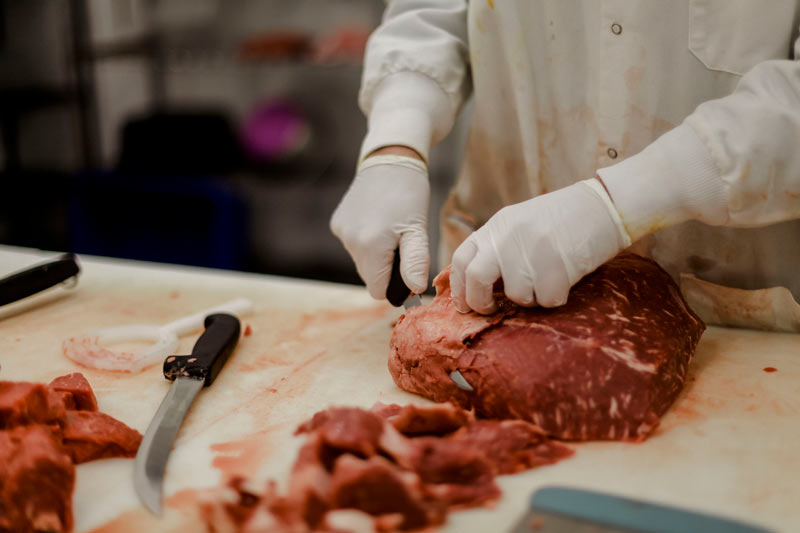Premium meat selections available at Bagley Meat Market Edwardsville IL for every occasion.
Premium meat selections available at Bagley Meat Market Edwardsville IL for every occasion.
Blog Article
Just How to Pick the Perfect Cut of Meat From a Trusted Meat Market
Choosing the excellent cut of meat from a relied on meat market calls for a thoughtful method that balances high quality, cooking function, and spending plan. Recognizing the different kinds of meat and their corresponding cuts is crucial, as is involving with your butcher to gain understandings right into sourcing and prep work.
Comprehending Meat Cuts


For circumstances, the tenderloin is prized for its buttery structure and minimal connective cells, making it suitable for fast cooking approaches such as barbecuing or pan-searing. On the other hand, harder cuts like the brisket or shank benefit from slow food preparation techniques to break down collagen, yielding rich and delicious results.
Furthermore, the fat web content of a cut plays an essential function in flavor profile and wetness retention throughout food preparation. Cuts with higher fat web content, such as ribeye, use an even more durable flavor, while leaner alternatives, like sirloin, may call for careful prep work to avoid dryness (bagley meat market edwardsville il). Comprehending these subtleties permits informed selections that boost cooking productions, making certain that each recipe showcases the very best qualities of the picked meat
Variables to Think About
When picking the perfect cut of meat, several critical variables enter into play that can significantly affect the last dish. Consider the kind of meat you want-- beef, pork, lamb, or fowl-- as each offers distinct flavors and structures. The certain cut within that category is similarly essential; for example, ribeye delivers rich marbling, while tenderloin supplies a lean, buttery structure.
An additional element is the food preparation method you prepare to use. Cuts suitable for barbecuing, such as T-bones or sirloins, vary from those much better fit for sluggish food preparation, like chuck roasts or shanks. Furthermore, freshness is vital; constantly pick meat with a vibrant color and company appearance, signifying quality and correct handling.
Furthermore, consider the resource of the meat. A relied on meat market frequently gives in your area sourced, hormone-free, and grass-fed options, which can improve flavor and dietary worth. Your budget will certainly lead your selection. Premium cuts may offer exceptional preference, yet there are additionally affordable choices that, when prepared correctly, can produce tasty results. Stabilizing these factors will help you select the best cut for your cooking demands.
Inquiries to Ask Your Butcher
A butcher's expertise can be indispensable when choosing the optimal cut of meat for your culinary ventures. Start by asking about the resource of the meat.
Following, inquire about the various cuts offered for the type of meat you like. A well-informed butcher will clarify the subtleties of each cut, assisting you pick one that matches your food preparation approach and wanted outcome. Don't think twice to ask about the most effective cooking techniques for a specific cut; butchers frequently have pointers that page can boost your dish.
It's also prudent to ask about the meat's freshness. Inquire regarding the shipment routine and exactly how typically the meat is restocked. This will offer you self-confidence in the quality of what you are purchasing. Ask for referrals based on your personal taste preferences. A great butcher will aspire to share their expertise and recommend cuts that will certainly thrill your taste. Engaging your butcher with these inquiries can considerably enhance your meat selection experience.
Identifying Quality Meat

Structure is an additional crucial aspect; high quality meat should really feel solid and somewhat bouncy to the touch. Avoid any kind of cuts that really feel slimy or exceedingly dry, as these can suggest wasting or improper storage. Additionally, scent plays an important function; fresh meat should have a tidy, neutral scent, while any kind of off-putting or sour smells are red flags.
Lastly, consider the source. Acquiring from a credible meat market, where the meat's beginning is understood, can ensure higher high quality criteria. By focusing on these signs-- color, marbling, structure, odor, and resource-- you can with confidence choose cuts that will certainly raise your food preparation and eating experience.
Cooking Methods for every Cut
Selecting the right cooking approach is critical for making best use of the imp source flavor and tenderness of each cut of meat. Various cuts possess special characteristics that dictate the most appropriate cooking strategies.
For tender cuts, such as filet mignon or ribeye, completely dry heat approaches like barbecuing, broiling, or pan-searing are suitable. These techniques improve the natural flavors while ensuring a juicy, delicious structure. Alternatively, harder cuts, such as chuck or brisket, advantage from damp warm techniques, including braising or sluggish cooking. These strategies aid damage down connective cells, resulting in a tender, delicious dish.
Pork chops and chicken breasts are flexible and can be cooked utilizing both dry and moist techniques. While grilling or roasting can generate scrumptious results, poaching or sautéing can preserve wetness and inflammation. For lamb, approaches like roasting or braising are suggested, as they enhance the meat's durable taste.

Final Thought
In conclusion, choosing the optimal cut of meat from a credible meat market requires an extensive understanding of meat cuts and factor to consider of different aspects, including source, top quality, and cooking methods. Engaging with the butcher with targeted inquiries can produce useful understandings and recommendations tailored to particular cooking needs. Focusing on both high quality and spending plan will certainly improve the total gastronomic experience, making certain that the chosen cut fulfills expectations in both flavor and prep work.
Report this page